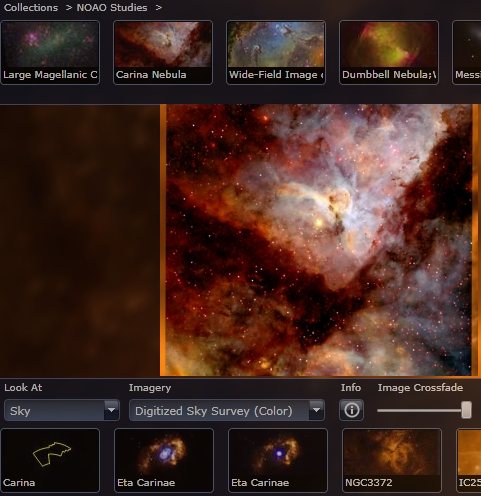WorldWide Telescope is a free astronomic telescope visualization software that allows to to use your computer as a virtual telescope. Indeed WorldWide Telescope brings all imagery of ground-based and space-based telescopes, to your computer. From your computer, you are able to visit the final frontier. This free astronomical telescope software captures terabytes of images, information and stories from an array of different sources. Students of all ages, as well as teachers and other academics, find WorldWide Telescope a fascinating trip through the cosmos. The application’s interface is simple and easy to navigate and understand.
WorldWide Telescope comes from Microsoft, and is available as a both web based client, as well as downloadable Windows based client. I tried web based client, and was absolutely amazed. I saw a Nebula, explored areas in space around it, and just loved the clarity of images around it. Let me warn you; using this free telescope software can become addictive. Microsoft has done a great job in putting together this software.
The creators of WorldWide Telescope had two missions in mind when they created this journey into the heavens. The first is to collect all scientific data from major telescopes, observatories and institutions around the world and make this data available for all via a single, cohesive internet-based portal. The second is to stimulate interest in science among young people. WorldWide Telescope aims at teaching astronomy as well as other facets to do with the cosmos.
For those that are keen to get started, you will find a dialogue box on the main interface that explains how to navigate the world of WorldWide Telescope. Follow the instructions until you are familiar with the controls as well as features. Click on the ‘Guided Tours’ tab. From here you are able to choose from a slew of tours created by various contributing astronomers and educators from some of the most prestigious institutions from around the world.
There are tours to the Milky Way to see how it condensers into stars and planets. Traveling back in time to view gravitational lens bending the light from galaxies. These are just two examples of the trips or tours that are available; there are many more. You can also “bookmark” the tour and resume the tour at another time, in the event you are busy.
The program utilizes Microsoft’s high performance Visual Experience Engine, this free application allows you to explore the universe as though you are a crew member on board the starship Enterprise. You are able to seamlessly pan the sky and zoom in on celestial features that are of interest. these include stars, nebulae, and planets. You are able to this plus a great deal more, all from a comfortable chair and a mouse click.
Space consists of many celestial objects radiate energy over an extreme wide range. These objects include, wavelengths; radio waves to infrared, optical ultra-violet and even x-rays. WorldWide Telescope is able to bring together information of these space objects thanks to contributions from such instruments as the Hubble Space Telescope, The Chandra X-Ray Observatory and the Sloane Digital Sky Survey.
Some other similar software we reviewed earlier include: Stellarium, and Celestia.
The data in WorldWide Telescope is not readily accessible; it is presented in such a way that it facilitates integrative research. Having an application like this enables the gap between research, education and public knowledge to be closed. Anyone, with an interest, can learn about space and what is out there. Indeed, with WorldWide Telescope, your computer is a virtual supercomputer and telescope to the stars.
The Microsoft research team has dedicated WorldWide Telescope to the memory of Jim Gray and thus released it as a free resource, for all. Try WorldWide Telescope Free.
